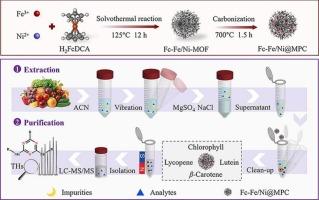含有二茂铁的 MOF 衍生多孔碳的制备与应用:通过 LC-MS/MS 简易分析各种水果和蔬菜中三嗪类除草剂的单一多干扰净化 QuEChERS 吸附剂
IF 9.8
1区 农林科学
Q1 CHEMISTRY, APPLIED
引用次数: 0
摘要
以含二茂铁金属有机骨架(MOF)为原料制备了一种新型磁性纳米孔碳(Fc-Fe/Ni@MPC),并将其作为多功能QuEChERS吸附剂用于LC-MS/MS前测定果蔬样品中的三嗪类除草剂。制备的Fc-Fe/Ni@MPC不仅保持了MOF前驱体原有的有序形貌,而且通过热解表现出高石墨化和良好的超顺磁性。吸附量分别为1163.25 mg/g、157.83 mg/g、157.69 mg/g和25.10 mg/g,对叶绿素、番茄红素、β-胡萝卜素和叶黄素具有疏水性、π-π和氢键作用。−14.2的方法给了微不足道的基体效应 % % ~ 10.8,低检测的极限0.001 - -0.04 80.2μg / kg和令人满意的复苏 % -112 %的橙色,柑橘,苹果,西瓜,西红柿,胡萝卜和生菜样品,当执行2 毫克的这个单一吸附剂在短短15 年代。本工作揭示了Fc-Fe/Ni@MPC作为一种多功能高效的QuEChERS吸附剂在大量富含色素的食品样品中预处理三嗪类除草剂的前景。本文章由计算机程序翻译,如有差异,请以英文原文为准。


Fabrication and application of ferrocene contained MOF derived porous carbon: A single multi-interference clean-up QuEChERS sorbent for facile analysis of triazine herbicides in various fruits and vegetables by LC-MS/MS
A novel magnetic nanoporous carbon (Fc-Fe/Ni@MPC) was fabricated from ferrocene contained metal-organic framework (MOF) and employed as multifunctional QuEChERS adsorbent for determination of triazine herbicides in various fruit and vegetable samples before LC-MS/MS. The prepared Fc-Fe/Ni@MPC not only maintained the original ordered morphology from MOF precursor, but also exhibited high graphitization and good superparamagnetism through pyrolysis. This sorbent afforded adsorption capacity of 1163.25 mg/g, 157.83 mg/g, 157.69 mg/g and 25.10 mg/g towards chlorophyll, lycopene, β-carotene and lutein via hydrophobic, π-π and hydrogen bonding interactions. The method gave negligible matrix effects of −14.2 % ∼ 10.8 %, low detection limits of 0.001–0.04 μg/kg and satisfactory recoveries of 80.2 %–112 % in orange, citrus, apple, watermelon, tomato, carrot and lettuce samples, when performing 2 mg of this single sorbent within just 15 s. This work revealed the prospect of Fc-Fe/Ni@MPC as versatile and efficient QuEChERS adsorbent for pretreatment of triazine herbicides in large kinds of pigment-rich food samples.
求助全文
通过发布文献求助,成功后即可免费获取论文全文。
去求助
来源期刊

Food Chemistry
工程技术-食品科技
CiteScore
16.30
自引率
10.20%
发文量
3130
审稿时长
122 days
期刊介绍:
Food Chemistry publishes original research papers dealing with the advancement of the chemistry and biochemistry of foods or the analytical methods/ approach used. All papers should focus on the novelty of the research carried out.
 求助内容:
求助内容: 应助结果提醒方式:
应助结果提醒方式:


